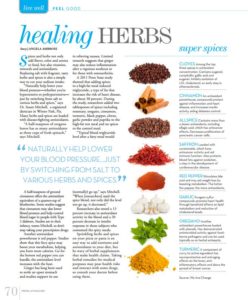
Spices and herbs not only add flavor, color and aroma to food, but also vitamins, minerals and antioxidants. Replacing salt with fragrant, tasty herbs and spices is also a simple way to cut your sodium intake.
Naturally help lower your blood pressure—whether you’re hypertensive or prehypertensive— just by switching from salt to various herbs and spices,” says Dr. Susan Mitchell, a registered dietician in Winter Park, Fla. Many herbs and spices are loaded with disease-fighting antioxidants.
“A half-teaspoon of oregano leaves has as many antioxidants as three cups of fresh spinach,” says Mitchell.
A half-teaspoon of ground cinnamon offers the antioxidant equivalent of a quarter-cup of blueberries. Some studies suggest that cinnamon may also lower blood pressure and help control blood sugar in people with Type 2 diabetes. Studies are in their infancy, warns Mitchell, so don’t stop taking your prescription drugs.
Another antioxidant powerhouse is red pepper. Studies show that this fiery spice may boost your metabolism, helping you burn more calories. Go for the hottest red pepper you can handle; the antioxidant level increases with the heat.
Ginger has long been used to settle an upset stomach and studies support its use in relieving nausea. Limited research suggests that ginger may also reduce inflammation after a vigorous workout or for those with osteoarthritis.
A 2011 Penn State study showed that adding spices to a high-fat meal reduced triglyceride, a type of fat that increases the risk of heart disease, by about 30 percent. During the study, researchers added two tablespoons of spices including rosemary, oregano, cinnamon, turmeric, black pepper, cloves, garlic powder and paprika to the high-fat test meal and no spices to the control meal.
 “Typical blood triglyceride level after a fatty meal would (normally) go up,” says Mitchell. “When [researchers] used the spice blend, not only did the level not go up, it decreased.”
“Typical blood triglyceride level after a fatty meal would (normally) go up,” says Mitchell. “When [researchers] used the spice blend, not only did the level not go up, it decreased.”
Researchers also noted a 13 percent increase in antioxidant activity in the blood and a 20 percent decrease in insulin response in those subjects who consumed the spicy meals.
Sprinkling herbs and spices on your pizza or pasta is an easy way to add nutrients and antioxidants to your diet, but be wary of herbal supplements that make health claims. Taking herbal remedies for medical purposes may pose health risks and interact with some drugs, so consult your doctor before using them.
Source: We Are Change
Published in Prime Living
Super Spices
Cloves
Among the top three spices in antioxidant concentration. Contains eugenol, carophyllin, gallic acid and eugenin. Inhibits oxidation of LDL cholesterol, an early step in atherosclerosis.
Cinnamon
An antioxidant powerhouse, compounds protect against inflammation and heart disease, and increases insulin activity, aiding diabetes control.
Allspice
Contains more than a dozen antioxidants, including ellagic acid, which has anticancer effects. Decreases proliferation of pancreatic cancer cells.
Saffron
Loaded with carotenoids, which have anticancer activity and aid immune function. Also protects blood fats against oxidation, a step in the development of cardiovascular disease.
Red pepper
Stimulates bile acid and may aid weight loss by boosting metabolism. The hotter the pepper, the more antioxidants.
Garlic
Pungent sulfur compounds promote heart health through beneficial effects on lipid metabolism and reduction of cholesterol levels.
Oregano
Another antioxidant powerhouse loaded with phenols. Has demonstrated antimicrobial activity against food-borne pathogens and can be used topically as an herbal antiseptic.
Turmeric
A component of curry, its active ingredient has neuroprotective and anti-aging effects on the brain, anti-inflammatory effects and slows the spread of breast cancer.